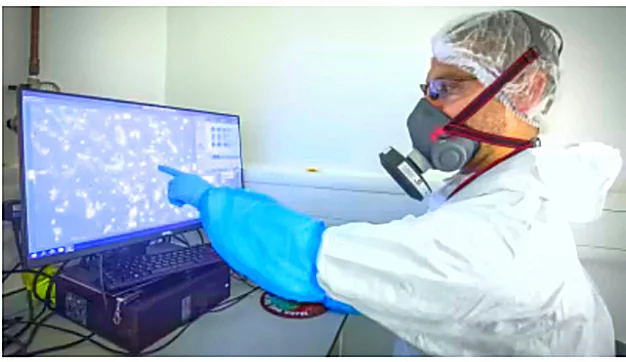Scientists Warn of More Than 25% Probability for Another Deadly Virus to Become Global Pandemic in the Next Decade.
Disease X…
Researchers worldwide are actively working on safeguards, and the UK government has recently allocated $65 million to establish a dedicated vaccine facility to combat the potential outbreak.
Dubbed ‘Disease X’ by the World Health Organization (WHO), this enigmatic virus poses a significant global threat, and its potency is escalating
The task is being meticulously executed within the secure confines of the government’s high-security Porton Down laboratory complex in Wiltshire. A dedicated team of over 200 scientists is leading this groundbreaking initiative at the forefront.
What is Diseases X ?
Disease X is a term used for any yet unidentified pathogen that has the potential to trigger a global pandemic.

Scientists are working diligently inside a new vaccine center to defend against ‘Disease X.’ Dr. Jenny Harries, the chief executive of the UK Health Security Agency, acknowledges that we can never be 100% certain about what Disease X will be, but preparations can be made for certain virus families.
The World Health Organization (WHO) suggests that Disease X is likely to be zoonotic, that meaning it is expected to be transmitted from animals, with the source being a large but limited pool.
The WHO estimates that there are 631,000 to 827,000 unknown viruses capable of infecting by humans.
Disease X is expected to emerge from a tropical, low or middle-income country with high biodiversity undergoing human-induced land use changes
Why is Its Threat Becoming More Probable?
Scientists warn that the likelihood of a new global pandemic originating from an unknown pathogen is increasing. This is attributed to a broader range of regions becoming conducive to insects typically confined to warmer climates.

The health impacts of climate change are already evident,” stated Dr. Isabel Oliver, the UK Chief Scientific Officer. “We are witnessing shifts in the distribution of vector-borne viruses, which are transmitted by mosquitoes and ticks.”
Dr. Harries added that all relevant threats are on the rise due to climate change. For instance, a recent discovery of Crimean-Congo hemorrhagic fever in Hampshire’s New Forest highlights the dangers. While it currently poses a moderate threat in the UK, the tick-borne virus is fatal in approximately 30% of cases.
The current mission involves exploring unexplored territory, as scientists compile a catalog of potential animal viruses capable of crossing to humans and rapidly spreading worldwide. This elusive and undefined threat has earned the name “Disease X.” The meticulous effort is driven by the awareness that identifying which of these potential pathogens will trigger the next pandemic remains a mystery
What Measures Are Being Taken to Safeguard Against Disease X
Nations worldwide are actively collaborating to establish defenses against Disease X, with the World Health Organization (WHO) convening a team of 300 scientists for this purpose.
In 2021, the G7 countries collectively committed to the ‘100 Days Mission,’ aiming to deploy a vaccine against any emerging pandemic threat within 100 days of its identification.
To support these efforts, the UK government has invested £65 million in establishing a new Vaccine Development and Evaluation Centre (VDEC) at the Porton Down facility.
The facility is equipped with 200 scientists who can now conduct 30 times more tests per week compared to the pre-coronavirus pandemic period.
Their focus is on combating dangerous category 3 viruses, which either lack a cure or cause severe damage and rapid transmission, such as Disease X.

Regarding the threat of Disease X, Dr. Harries stated, “We can make some educated guesses by analyzing changes in the epidemiology of various viruses and considering climate shifts, but we can never be 100% certain. Our approach involves monitoring known viruses closely. For instance, with Covid, we continue to test new variants using provided vaccines to ensure their efficacy. Additionally, we are actively researching how swiftly we can develop a new test if a completely novel virus emerges
The Growing Horizon of Vaccine Development
The Vaccine Development & Evaluation Center at the Porton Down facility has extended its scope beyond COVID to address the looming challenge of “Disease X.” Initially dedicated to assessing vaccine effectiveness against emerging COVID variants, the scientists have now shifted their focus to closely monitor several high-risk pathogens. Notably, their attention is on bird flu, monkeypox, and hantavirus—a disease transmitted by rodents
Rising Risks Amplified by Climate Change
A study has unveiled that climate change and population movements are intensifying the likelihood of a new pandemic. Urbanization and changing ecosystems have facilitated the transmission of viruses across species, as evident in cases like bird flu. Climate shifts have allowed disease-carrying vectors such as ticks and mosquitoes to migrate into regions previously unsuitable for their survival. As the study emphasizes, “Our world is facing an escalating global threat driven by factors like urbanization and climate change
FAQs
1.What is the definition of X virus?
Disease X is the mysterious term given to the highly alarming risk posed by unfamiliar viruses to human health. Included in a concise list of pathogens prioritized for investigation by the World Health Organization, Disease X shares the spotlight with well-known threats like SARS and Ebola.
2.What is the new Disease X?
pleas rewrite this properly “As outlined by the World Health Organization (WHO), “Disease X represents the recognition that a major worldwide epidemic could emerge from a pathogen presently not identified as a source of human illness



